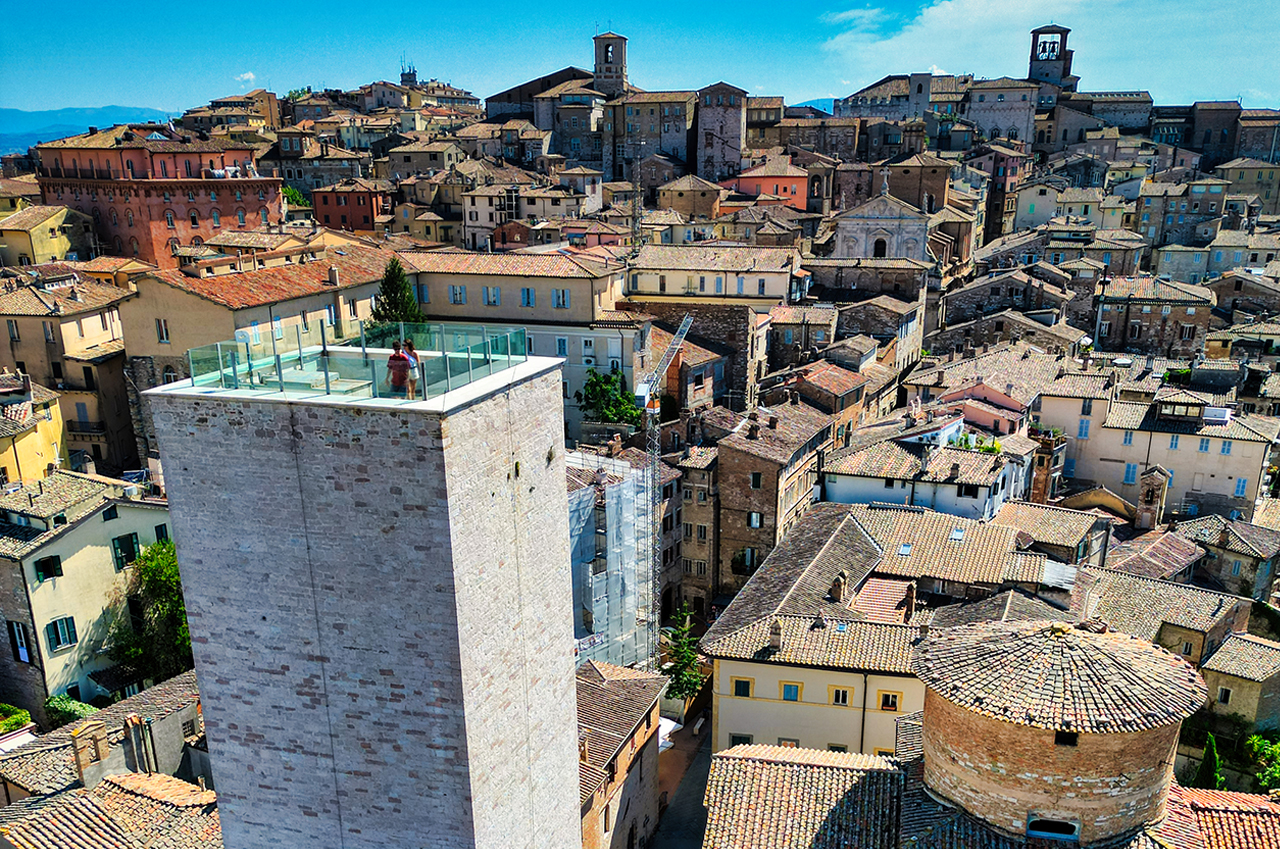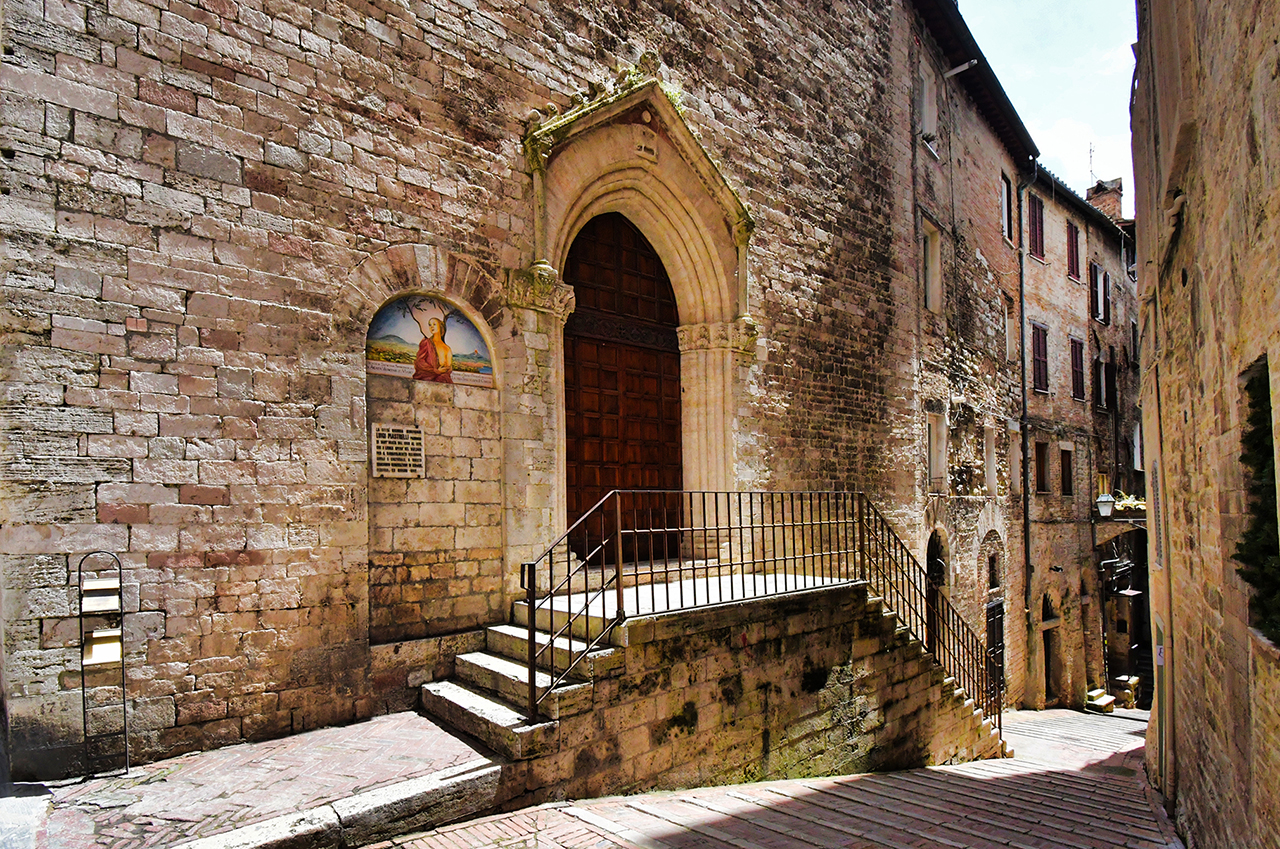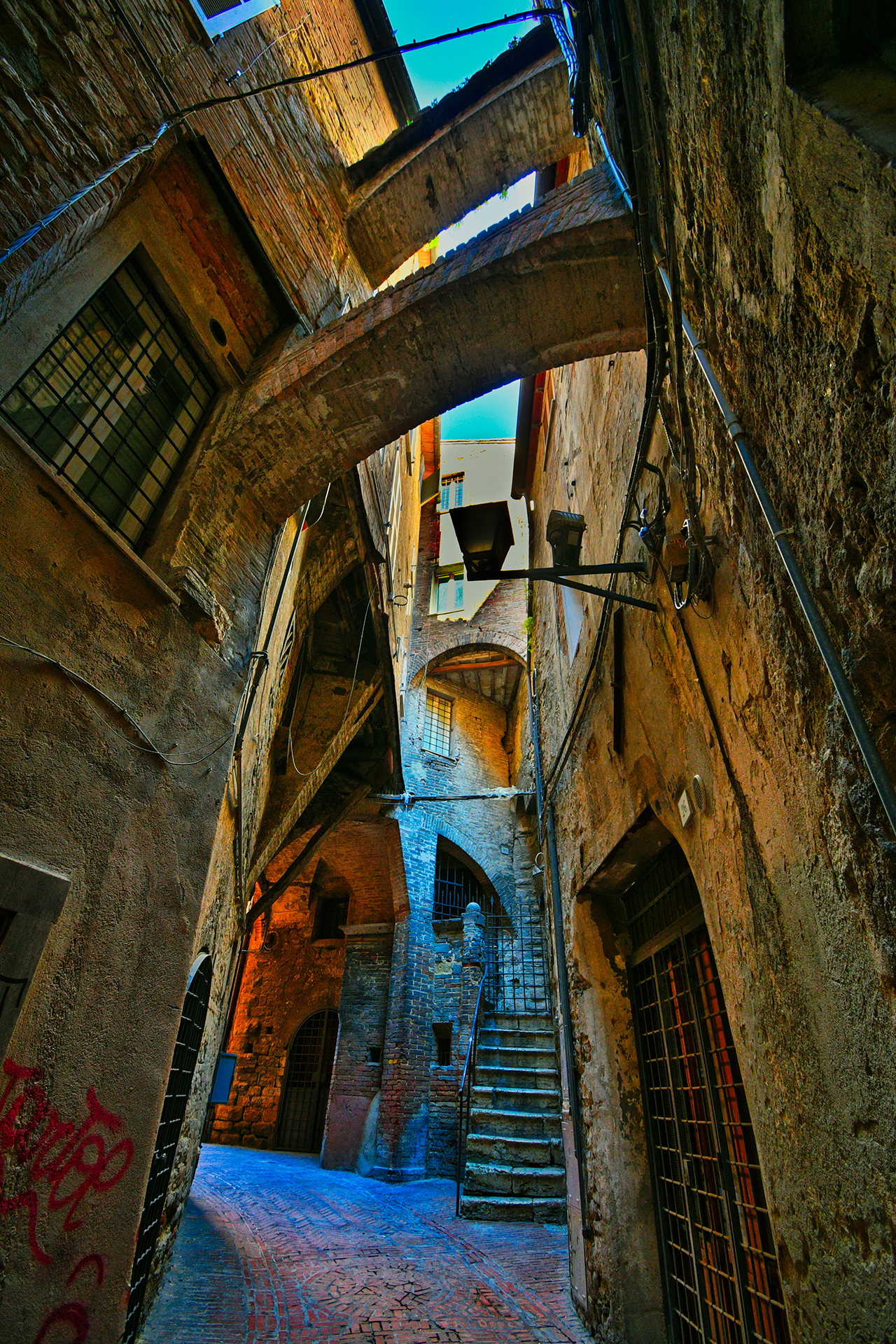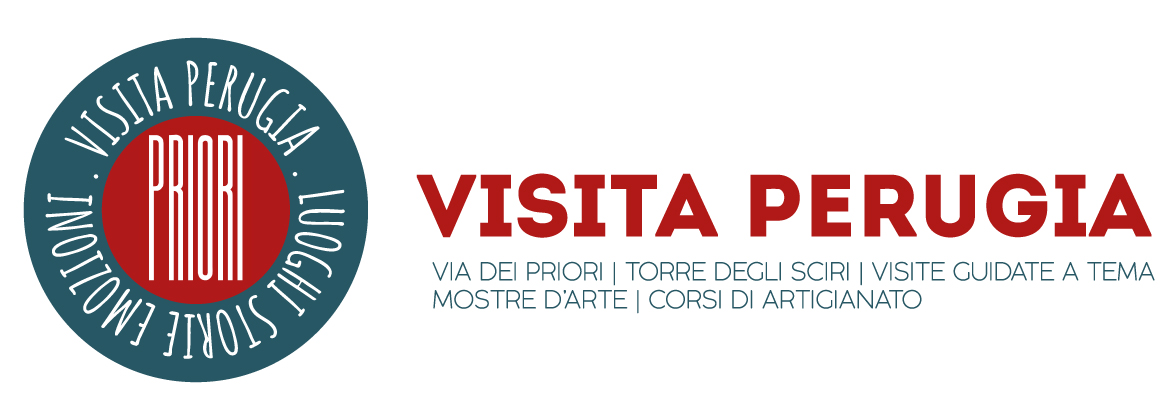Via dei Priori. The name derives from the name of the ten magistrates (decemviri or priori), who in the Middle Ages held the city government until the early eighteenth century. Ancient Etruscan road axis and Roman decumanus, then royal street of Porta Santa Susanna, Via dei Priori is outlined starting from the arch of the Palazzo dei Priori and connects the heart of the city with the road that, leaving Porta Trasimena, leads to Lake Trasimeno and Tuscany. Over time it has earned the nickname of a sacred street due to the construction of numerous religious settlements, such as churches and oratories. It has also been enriched with various private buildings, thanks to the renovation of the buildings carried out over the last three centuries. The peculiar property of the street is its characteristic windiness (Penna, 1973).
Today Via dei Priori is one of the main access roads to the historic center. It is a street rich in commercial activities and artisan laboratories. The Torre degli Sciri emerges from the city skyline, a symbol of the street and of Perugia.
Characteristic medieval alleys branch off from the main route of Via dei Priori, often winding, narrow, steep and covered by vaults which lead to large and small squares to be reached by walking with the nose upwards, to admire the architectural details and the ‘suspended’ gardens of city buildings.

Today Via dei Priori is one of the main access roads to the historic center. It is a street rich in commercial activities and artisan laboratories. The Torre degli Sciri emerges from the city skyline, a symbol of the street and of Perugia.

Characteristic medieval alleys branch off from the main route of Via dei Priori, often winding, narrow, steep and covered by vaults which lead to large and small squares to be reached by walking with the nose upwards, to admire the architectural details and the ‘suspended’ gardens of city buildings.
Piazza Ferri. Formerly Piazza del Naspo and Piazza della Chiesa Nuova. From 1871 it is named after Baldassarre Ferri (1610-1680), famous treble voice, here buried in the Church of San Filippo Neri. This is probably also due to the fact that the district, which extends from Via Fratti to the Auditorium of Santa Cecilia, was considered the musical district of the city in the 19th century.
Piazza Morlacchi. Formerly Piazza Aureli and Piazza del Teatro Civico.It is dedicated to Francesco Morlacchi (1784-1841), musician and composer, especially of sacred music. Since 1874, the theater in the square, built by the city bourgeoisie in 1780 with the name of Teatro del Verzaro, has also been named after him.
Piazza San Paolo. Located in front of a former Clarissian monastery, it owes its name to the homonymous church of Colle Landone, demolished on the occasion of the construction of the Rocca Paolina. Since the national unity it houses the Liceo Classico ‘Annibale Mariotti’, then reunited with the Gymnasium in 1897.
Piazzetta del Drago. Located at the top of the Canapina, in the courtyard of the former Benincasa Conservatory, now elementary school. The small square was once ‘parking‘ for the donkeys of those who went up to the city from the countryside: “Rather than a small square, it was a countryside area, where the dragon does not really hide, but the donkeys can breathe and graze in peace.” (Frezzini, 1893)
Via Armonica. A name that could derive from a musical instrument laboratory that existed here, or from a factory of harmonic strings. At the beginning of the street, on the left, there is a stone basin, with a tap, belonging to a source or a well, perhaps the same one that was located, until the beginning of this century, at the Piazza di San Francesco al Prato.
Via Benincasa. It is home since the eighteenth century to the institute for poor orphans, also called Conservatory of Provisions, founded and maintained with a testamentary bequest by Michelangelo Benincasa (1671-1716). The building was rebuilt and enlarged in 1842. Along the stretch of the road that curves towards Via dei Priori, also called Vicolo Santa Croce, overlooks the Church of Santa Croce.
Via Cumana. A name that has aroused discordant opinions in historians. At the beginning of the road and in front of it there were once two towers. On the edge of the first building, on the left, two gracious coats of arms of the owner family.
Via degli Offici. Formerly Via San Gregorio, Via San Bernardo, Via Chirurgica. It leads to the square where the offices were. These are no longer there, but the name has remained.
Via degli Sciri. It takes its name from the ancient family of Sciri, counted among the patrician families of Perugia in 1494 and extinct towards the end of the seventeenth century, which here had its houses dominated by a tower (in fact called Torre degli Sciri) about 46 meters high.
Via dei Gatti. A unique way, closed at the beginning of this century.A way for the exclusive use of the cats to which it is entitled: once a day the garbage man opens its gates either from the Via dei Priori or from the Deliziosa and – cleaned it – locks it so that no other human animal dares disturb the feline matters. ” (Gigliarelli, 1907)
Via del Cefalo. Side street of Via della Sposa.
Via Deliziosa. At number 7of the street there is a plaque, placed in 1923, dedicated to General Fulvio Riccieri, silver medal of the First World War.At number 17 as shown by the plaque on the door, there is the house belonging to Pietro Vannucci ‘il Perugino’. The house is faced by the façade with bell tower of the former Church of Sant’Antonino, believed to be from the 11th century.
Via del Lauro. Via del Piscinello that extends to Via della Sposa.
Via del Poggio. It is a charming hillock, above vegetable gardens and gardens, from which one can enjoy a magnificent view of the Church of San Francesco al Prato, the Oratory of San Bernardino and the grassy area opposite. A plaque indicates the birthplace of Maria Alinda Bonacci Brunamonti.
Via del Silenzio. Street that outlines from Via della Cupa to the Piazzetta del Drago.
Via dell’Orso. In the Middle Ages it was the custom of noble families and some municipalities to raise bears, lions and other exotic animals for the curiosity and amusement of the people. The origin of the name comes perhaps from the presence of a bear that was once kept in this way.It is interesting to note that this animal was also the symbol of the Porta Santa Susanna district.
Via della Canapina. In this place the cordari or canapari, hence the name of the street, made and stretched the ropes. In the past, the two walls of the city met at the top of Via della Canapina to merge in the stretch of the Cupa.
Via della Cupa. The denomination is due to its physical conformation, cuppa ‘hollow container’. Via della Cupa is based on a section of the Etruscan walls that, in this place particularly landslide, have an important support function and that curve following the deep inlet drawn by the steep slopes of the hill, at whose feet a sewer, called since 1326 the cul of Borgna, collected the waters that flowed from the city.
Via della Pernice. “The Via della Pernice, which the game hunters […] of 1810 wanted to name like this, is detached from the Vincioli offering the gracious view of a house rebuilt in the ancient style of the eminent patriotic lawyer Antonio Brizi” (Gigliarelli, 1907). House also belonged to the Frolliere, the historian of the Salt War.
Via della Sposa. It owes its name to an episode concerning an inhabitant of Perugia, which occurred in 1351, which after suffering love pains and, it is thought, after being relieved by an evil eye, on the wedding day crossed the road, greatly celebrated. Speaking of magic, the quadrivium at the top of the street, under the Porta Trasimena, had a bad reputation: it was, in fact, considered an ‘inauspicious place’ because just there ‘charm’ objects were burned.
Via della Stella. At number 1 and 9 there are two towers, easily recognizable by the cornerstones and the height greater than the adjacent buildings. Opposite is the former Oratory of Santa Cecilia.
Via Francolina. Dedicated to the ancient Perugian family of Francolini, whose residence was located in this area, and which probably built the Church of Santa Maria dei Francolini, still visible.
Via Fratti. Formerly Via dei Perinelli, Via San Gregorio and Via dell ‘Oratorio.It is named after Antonio Fratti (1849-1897), a politician and man of action, who died in combat. It was built by the Perugian comrades-in-arms of man.
Via Guardabassi. Formerly Via Retta. Since 1781 it has been dedicated to Francesco Guardabassi (1793-1871), a patriot and a figure much loved by the Perugians not only for his political commitment but also for his humanitarian commitment, having sacrificed his family heritage on the occasion of public calamities, as a plaque placed in this street on the house where he was born and died recalls.
Via Maestà delle Volte. It owes its name to the Maestà (a term which in ancient times indicated a sacred image placed in an aedicule along a road), located under the vaults supporting the primitive mayor’s palace, which once covered the road.This fresco, painted in 1297 and repeatedly remodeled, represents the Madonna and Child among the angels. The street was renovated and extended between 1927 and 1929, the year in which the fountain was placed in medieval style designed by Pietro Angelini. Along the covered stretch of the street, there is the ceramic by Germano Belletti from 1945, representing the patron saints Ercolano and Costanzo who present Perugia to the Madonna: a sort of ex-voto for the escaped destruction of the Second World War.

Via Ritorta. A narrow street that has preserved much of the appearance it had in the Middle Ages, it is among the most scenic of the interesting and dense road that develops from both sides of Via dei Priori, and deserves to enter it with a ‘nose for air’. So named for its winding path it is considered one of the most authentic medieval alleys of the historic center.
Via Sant’Agata. It takes its name from the ancient church of the same name, in front of which the road begins. In the Church of Sant’Agata were usually buried prisoners who died in the nearby prison of the Palazzo dei Priori.
Via Vermiglioli. Formerly Via Vermiglia.It took its name from the seventeenth-century Palazzo Vermiglioli, built at number 16 of the street by the homonymous family, of which Giovanni Battista Vermiglioli (1769-1848) is especially remembered. Founder of the Chair of Archaeology and the Archaeological Museum of Perugia, he wrote the first monograph on the Fontana Maggiore, and was so famous as to attract Giacomo Leopardi, hosted by him from 10 to 20 November 1828. At number 5 of the street lived from 1916 to 1927 the great Perugian poet Sandro Penna (1906-1977), who then moved to Rome.
Via Vincioli. It takes its name from the ancient and noble family that has lived there for about six centuries. The most famous exponent of this family is San Pietro Vincioli, who lived around 1000, owner of the fief of Agello and abbot of the Abbey of San Pietro, of which he is considered the founder. Tradition sees him as the protagonist of a miracle, since it is believed that he made a column that was about to collapse remain suspended with a sign of the cross.

